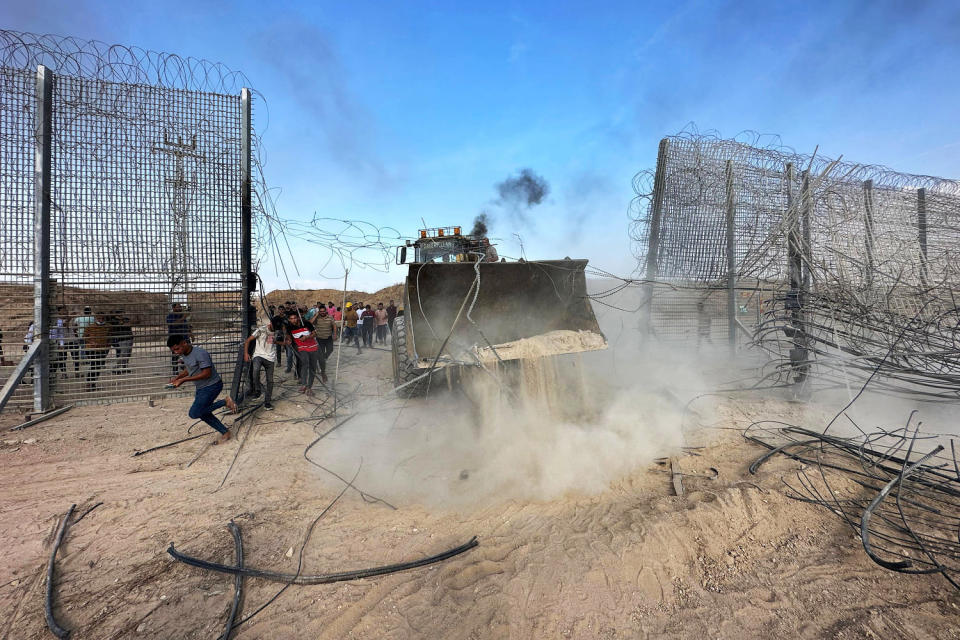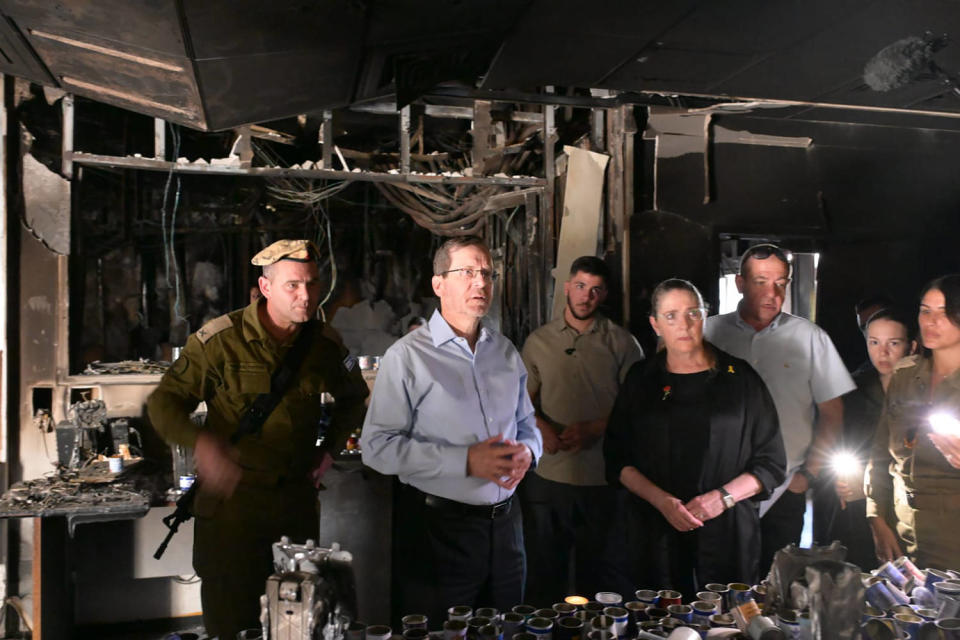TEL AVIV — They were Israel’s eyes on the border with Gaza, but former soldiers from a military observation unit say their warnings about suspicious Hamas activity ahead of the Oct. 7 terror attacks were repeatedly ignored. A year later, they are still seeking answers.
“If I had been valued a little more — not much, just a little — maybe it could have ended differently,” Roni Lifshitz, one of the former observers, told NBC News last month. “It’s anger and sadness, mainly frustration, because I was there and no one listened to me.”
Lifshitz, 21, was part of the Israel Defense Forces‘ unit 414 stationed at the Nahal Oz military base on the Gaza border. Soldiers in the all-women field observers team, most just 19 or 20 years old and fulfilling their mandatory military service, would spend hours glued to feeds from surveillance cameras watching for threats.
In the months leading up to Oct. 7, Lifshitz said she started noticing unusual activity. Truckloads of Hamas militants, which appeared to be special forces units because they were all dressed in black, were driving within 300 yards of the fence, in a “combat patrol,” she said. After they stopped, she said they would carefully scan Israeli positions while talking amongst themselves.


On another occasion she said she saw militants using a “model of an Israeli tank they had built to train to kidnap soldiers. They were actually practicing scenarios that happened on Oct. 7,” she said.
Lifshitz said she reported all of these events up the official chain of command, but was met with silence. “No one updated me. No one told me, ‘Roni, what you reported is being handled,’ or ‘Just so you know, they’re doing something about it, they’re dealing with it, they heard about it.’ No one said anything to me,” she said.
On the morning of the attacks, Lifshitz was training in Jerusalem.
Hamas militants stormed the Nahal Oz Base and 15 of Lifshitz’s colleagues — all young women like her —were killed in the assault. Seven more were dragged away into Gaza. Video taken on the day of the attack shows some of the young women covered in blood. Most were wearing sweatpants and the clothes they were sleeping in. Some were later seen in the streets of Gaza being put in jeeps and trucks.
One of Lifshitz’s colleagues, Ori Megidish, was rescued weeks after the attacks, and another, Noa Marciana, was killed at the Al-Shifa Hospital in northern Gaza, according to the Israeli military. Five are still in captivity.


Lifshitz said she was trying to put on a positive front while she worked in a shoe store, but she cried herself to sleep every night, wracked with the ever-present guilt of having survived.
“Everything I do comes with the feeling of, ‘Why me and not them? Why am I different from them? Why were they murdered, and I wasn’t?’”
She and other surviving members of unit 414 are also seeking answers.
“I want an answer to just one question,” she said. “Who received the information and didn’t give the order to do something about it? Who turned a blind eye, and who is responsible for this?”
Asked whether the warnings issued by the observers were acted upon or ignored, the Israeli military told NBC it is currently focused on fighting Hamas and “questions of this kind will be looked into at a later stage.”
After a July meeting between the observers, their families and Israel’s Prime Minister Benjamin Netanyahu, his office said in a statement that he heard their requests for an investigation and promised that “matters would be thoroughly checked and that the lessons would be learned at all levels.”
Speaking Tuesday on a visit to Nahal Oz, Israeli President Isaac Herzog said it was the site of “a terrible massacre.”
“I very much hope that the investigation will be published fully and comprehensively, to shed light on everything that happened. It won’t change reality, but it’s good that we know the truth in order to draw lessons,” Herzog said.
But so far, Israel has not launched an official inquiry, despite pleas from the families of observers and other victims of the attacks.
Undeterred, surviving members of unit 414 have been making their concerns public.
In September, Lifshitz and two other former soldiers, Amit Yerushalmi and Margaret Weinstein, took part in an unofficial civil commission of inquiry that has been collecting evidence of intelligence failures around the Hamas attacks, which saw 1,200 people and around 240 people taken hostage, according to Israeli tallies. Israel’s offensive in Gaza since then has killed more than 41,000 people, according to health officials in the enclave.
Weinstein testified to equipment failures on the base, including surveillance cameras that had fallen down or didn’t work properly. Yerushalmi also alleged that the pattern of suspicious Hamas activity was increasing in the weeks leading up to the attack.


Both echoed Lifshitz’s allegations that their claims were ignored.
The commission was started by Ofer Rosenbaum and Haim Rubenstein as part of a promise that Rubenstein made to Eyal Eshel, the father of 19-year-old Roni Eshel, an observer from the unit who was killed at the base.
Varda Alshech, a retired judge, leads the commission. Other members include retired Maj. Gen. Eyal Ben-Reuven, retired Brig. Gen.General Yehudit Grisaro and Shlomo Aharonishki, who served as the high commissioner of the Israeli Police between 2001 and 2008. Raphael Ben-Sheetrit, the former mayor of the northern town of Beit She’an, also sits on the commission.
“We’re looking for an answer to the families — what really happened?” said Rubenstein, who, like Rosenbaum, worked in crisis management before the attacks. “If the army failed, I need to understand what’s happened in the army. If the government failed, I need to understand what’s happened over there.”
Despite receiving no support from the government, the commission is pressing on with the investigation and plans to release a preliminary report next month.
“If Israeli citizens will not have these answers, how can we make sure that this will never be happening again,” Rosenbaum said of their mission.
Other former and current soldiers have also testified before their commission, as well as members of the intelligence community, journalists, former prime ministers and other government officials.
In August, opposition leader Yair Lapid testified that, two months before the Oct. 7 attacks, he had taken part in a military intelligence briefing in which Netanyahu received detailed warnings that Hamas had noticed a weakness, division and a loss of military competence in Israel.
Netanyahu appeared “bored and indifferent,” he said.


Danny Yatom, the former head of Israel’s Mossad intelligence agency, also testified on Sept. 10.
Speaking to NBC News at the commission’s offices in Tel Aviv on the day of his testimony, Yatom said he did not have an explanation for Israel’s security failures, but said all the layers of defense in Israel, in his assessment, “collapsed at the same time.”
He added that Netanyahu “is responsible because he got some early warning, even though it was not the exact date, the exact location. He did not pay attention to it the way the prime minister should pay attention to it.”
These days, Lifshitz wears a necklace with a small photo of her friend Shahaf Nissani, a young woman with a big mass of curly, chestnut colored hair spilling out and around her face and across her neck. She was Lifshitz’s best friend, and a fellow observer, who was also killed at the base.
When customers at her shoe store ask her about the necklace, she tells them about her friend and then tries to change the subject.
“People can see I hide my emotions,” she said. “I laugh, joke, and seem happy and go out, but my heart is broken, black. There’s no soul, nothing.”
This article was originally published on NBCNews.com







